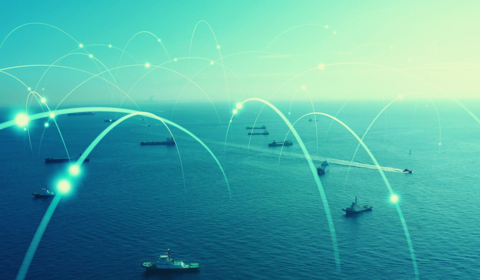
How digitalization is winning over the maritime industry
The marine and offshore industry is experiencing a watershed moment, as 2020 is ushering in the era of maritime digitalization. Technology is sweeping through the maritime world at an unprecedented rate, bringing increases in remote work, predictive maintenance, and unmanned platforms. These changes are giving ship owners, offshore operators, technical experts, digital solutions providers and classification societies opportunities to improve safety, efficiency and cost-effectiveness.
2020 brought numerous changes to the maritime industry’s day-to-day operations, including the notable rise of remote work. The COVID-19 pandemic forced marine and offshore surveyors to work from home, as governments worldwide closed their borders and instituted travel bans. With onsite inspections off the table, the industry turned quickly to another solution: remote maintenance inspections.
Remote maintenance inspections give experts digital access to marine and offshore assets via technology (e.g., cameras, computers, smartphones). Marine and offshore operators have several options for conducting remote inspection and verification, giving them much-needed flexibility. Onboard personnel can live stream directly with remote surveyors. Onshore personnel can also send information to remote surveyors. And onboard surveyors can remotely share information with subject matter experts.
This virtual expertise enables ship and offshore unit owners to make fast, accurate decisions about asset maintenance. Rather than bringing experts onsite one at a time to perform specific tasks, a single onboard inspector can easily contact multiple remote experts for input. In addition to being more convenient, remote inspections are a safer and more cost-efficient option for asset owners. Surveyors are no longer required to be onsite in potentially unsafe environments, and asset owners can eliminate travel and lodging costs.
Looking forward, the prevalence of remote maintenance inspections could have profound implications for future surveyors. As more inspection data is collected from assets, and onsite visits remain unlikely, the industry will have a unique opportunity to train new surveyors with the latest digital tools. Like its aerospace and automotive industry counterparts, the maritime world will soon be able to integrate immersive virtual reality technology and 3D simulations into surveyor training sessions.
Optimizing asset management with predictive maintenance
Increased digitalization is also advancing asset monitoring and maintaining by leaps and bounds. Traditional asset monitoring has been a time-consuming process dependent on gathering data from 3rd party sources and onboard equipment. Operators are tasked with combining data sources, logging information into management systems and defining the actions to be taken (e.g., oil and filter changes, system updates). This creates a cycle of uncoordinated updates, as crewmembers perform individual maintenance without understanding the overall state of the asset.
The spread of digital twin technology is changing the playing field for ship and offshore unit owners and operators, offering a deeper understanding of assets. Digital twins offer an interactive, up-to-date view of asset condition. They can store all information about asset history and activity, and enable in-house and external surveyors to take an asset-specific approach to maintenance. Marine and offshore experts can then make decisions to mitigate risk and optimize repairs based on the latest data, which is neatly compiled by the digital twin. The digital platform can also be used to make short-term repair decisions, accessing data from anywhere in the world.
Beyond this, the predictive function of digital twins is a boon for improving quality and lowering costs. Asset managers can plan out multiple scenarios to determine the optimum maintenance strategy, improving work scope definition and efficiency to limit costs. Unit operators and managers can more easily justify maintenance spending, pinpointing the best strategies for optimizing asset operations.
Navigating the future of unmanned assets
Finally, digitalization is at the heart of one of the maritime industry’s key long-term objectives: achieving unmanned operations.
For offshore platforms, this means developing units where daily operations are controlled by either onshore teams or neighboring platforms. Semi-automated offshore platforms already exist, and the benefits are clear: reduced costs, improved safety, increased efficiency and limited risk of unproductive shutdowns. Offshore wind farms are in a similar position, with newer projects being developed for limited personnel and increased onsite sensors and instrumentation.
Smart shipping is still in the early stages of development, with equipment manufacturers designing a range of onboard technologies to enable increased connectivity and automation. A handful of short-sea autonomous vessels are already operating in Europe, laying the groundwork for future unmanned ships.
Still, unmanned operations face challenges beyond those of technical development. The question of liability – who takes responsibility for an accident involving an unmanned asset – will be key to getting insurers and charterers onboard. The industry may also see resistance from crewmembers, whose role in operations would be greatly reduced.
Where digital advancement meets expertise
Having technology available onboard and offshore is a good start, but it is only the first step on the path to full maritime digitalization. Marine and offshore stakeholders need to understand the digital tools around them and how to make the most of their resources. This is where BV Solutions M&O comes in.
Since the beginning of 2020, BV Solutions M&O has been working remotely to provide key services to our clients, including:
- Remote inspection: We are coordinating with service providers to conduct remote inspections according to clients’ needs. Our presence in technical centers and remote survey centers helps us provide services to marine and offshore clients worldwide
- Predictive maintenance: Our digital solutions are providing asset managers smart, cost-efficient maintenance strategies using condition-based monitoring and reliability-centered maintenance. Clients benefit from our digital twin technology throughout the asset life cycle, improving maintenance and optimizing operations.
- Unmanned operations: Our experts are collaborating with key industry partners to advance autonomous shipping and unmanned platforms to the next stage.
As the maritime industry accelerates its transformation, we are working with clients to see them smoothly through this transition – and watch them conquer the digital future.